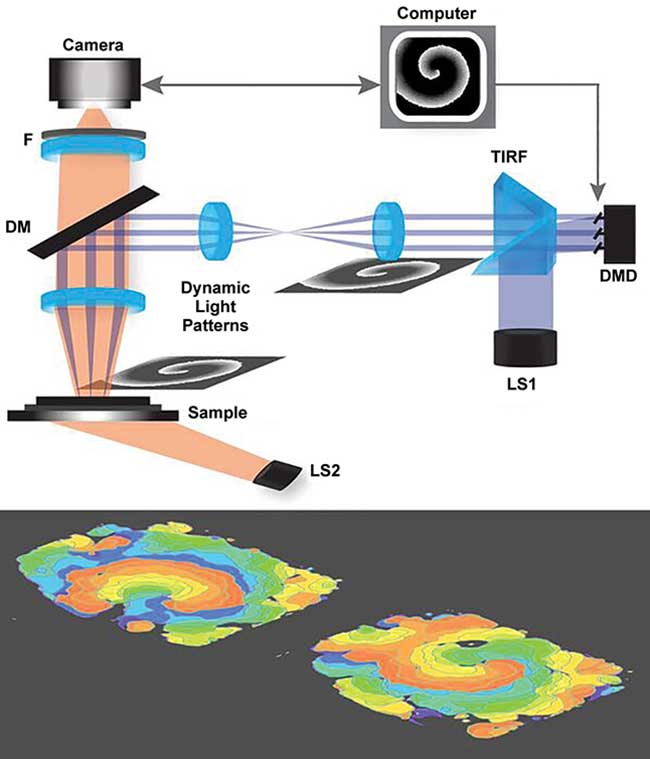The potential applications are vast, but uncertainty lingers as to whether the remaining challenges can ever be resolved.
 The next decade is going to be a telling one for those working in pursuit of cardiac optogenetics. Initial proofs have been demonstrated, the optical tools have been developed and scientific evidence has grown to a point where the tremendous potential of this technique is clear. Cardiac optogenetics holds out the promise of a wide range of clinical possibilities from halting heart attacks and treating arrhythmia to displacing the need for animal testing of drugs.
But there are doubters, even among the researchers themselves, that the remaining hurdles may, in the end, prove too complex to bring this promising technique into the clinic.
Cardiac optogenetics was first demonstrated in 2010 by Bruegmann et al. in a paper published in the journal Nature Methods. In the research, pulses of light were applied to the hearts of mice in which light-sensitive proteins had been specifically introduced. The process, known as transgenesis, uses gene transfer — in this case to insert proteins that render the heart muscle cells (cardiomyocytes) sensitive to blue light.
“Cardiac optogenetics is an exciting new area of research, not only for investigation of mechanisms involved in heart pathologies, but eventually also for treating cardiac arrhythmia in patients,” said Dr. Philipp Sasse of the department of physiology at the University of Bonn, Germany, one of the scientists who wrote the pioneering 2010 paper.
“Since our first report in 2010 using light to stimulate cardiomyocytes in vitro and to pace the heart from transgenic mice in vivo,” he said, “the field of cardiac optogenetics has emerged and is still expanding.”
Among the most significant developments since 2010 is optogenetic defibrillation in transgenic mice, which can terminate a lethal cardiac arrhythmia using light. Optogenetic stimulation has marked advantages over current electrical approaches such as low energy consumption, cell-specific stimulation and high spatial precision. However, the transgenesis process, which is the essential first step in utilizing optogenetics, creates its own set of problems. The gene transfer of light-sensitive proteins to the heart often triggers an immune response. Although Sasse has shown that the process causes no side effects in mice, it is still unclear whether this will be the case in humans or if efficacy will be maintained in the long term.
Despite this, research into the possibilities of cardiac optogenetics continues. At George Washington University, professor Emilia Entcheva, together with professor Gil Bub at McGill University, is exploring optical cardiac electrophysiology in which optics is used to both stimulate cells and record from them.
The next decade is going to be a telling one for those working in pursuit of cardiac optogenetics. Initial proofs have been demonstrated, the optical tools have been developed and scientific evidence has grown to a point where the tremendous potential of this technique is clear. Cardiac optogenetics holds out the promise of a wide range of clinical possibilities from halting heart attacks and treating arrhythmia to displacing the need for animal testing of drugs.
But there are doubters, even among the researchers themselves, that the remaining hurdles may, in the end, prove too complex to bring this promising technique into the clinic.
Cardiac optogenetics was first demonstrated in 2010 by Bruegmann et al. in a paper published in the journal Nature Methods. In the research, pulses of light were applied to the hearts of mice in which light-sensitive proteins had been specifically introduced. The process, known as transgenesis, uses gene transfer — in this case to insert proteins that render the heart muscle cells (cardiomyocytes) sensitive to blue light.
“Cardiac optogenetics is an exciting new area of research, not only for investigation of mechanisms involved in heart pathologies, but eventually also for treating cardiac arrhythmia in patients,” said Dr. Philipp Sasse of the department of physiology at the University of Bonn, Germany, one of the scientists who wrote the pioneering 2010 paper.
“Since our first report in 2010 using light to stimulate cardiomyocytes in vitro and to pace the heart from transgenic mice in vivo,” he said, “the field of cardiac optogenetics has emerged and is still expanding.”
Among the most significant developments since 2010 is optogenetic defibrillation in transgenic mice, which can terminate a lethal cardiac arrhythmia using light. Optogenetic stimulation has marked advantages over current electrical approaches such as low energy consumption, cell-specific stimulation and high spatial precision. However, the transgenesis process, which is the essential first step in utilizing optogenetics, creates its own set of problems. The gene transfer of light-sensitive proteins to the heart often triggers an immune response. Although Sasse has shown that the process causes no side effects in mice, it is still unclear whether this will be the case in humans or if efficacy will be maintained in the long term.
Despite this, research into the possibilities of cardiac optogenetics continues. At George Washington University, professor Emilia Entcheva, together with professor Gil Bub at McGill University, is exploring optical cardiac electrophysiology in which optics is used to both stimulate cells and record from them.
Member Exclusive: To read the complete article, please Login or Register